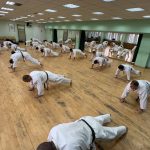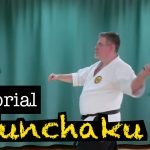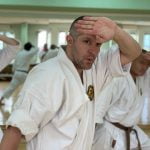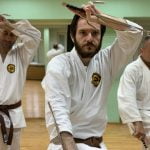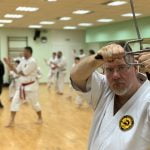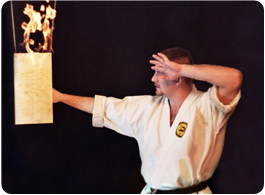Hojo undo is supplementary exercises where one uses various implements and aids to encourage and develop ambidextrous physical strength, stamina, muscle co-ordination, speed and posture.
Hojo undo is not practiced merely for the development of physical strength, but rather it has many other benefits associated with its consistent practice and logical approach. There are various implements that should all be used to aid your all round development. The ones that I will concentrate on are the makiwara (striking board), chi-shi (weighted lever), kami (gripping jar), tan (barbell), sashi (weights) and tetsu geta (iron clogs). This is by no means all the implements that one can use, there are others as well.
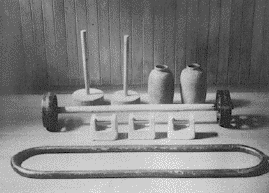 The benefits of this type of training are enormous, however they have to be practiced consistently and correctly. Always check, before and after practice, that your implements are in good condition and clean. Also put everything that you use back in the correct place afterwards. This is an important habit to develop in your dojo with all equipment, eg. focus pads, dojo floor etc. Use the implements in an area that will cause no harm to yourself and others around you. Work according to you limits and whilst you must push yourself, do not overdo your practice.
The benefits of this type of training are enormous, however they have to be practiced consistently and correctly. Always check, before and after practice, that your implements are in good condition and clean. Also put everything that you use back in the correct place afterwards. This is an important habit to develop in your dojo with all equipment, eg. focus pads, dojo floor etc. Use the implements in an area that will cause no harm to yourself and others around you. Work according to you limits and whilst you must push yourself, do not overdo your practice.
Listen to your body and if you are in pain then stop or cut back on the number of reps. Do not use implements that are far too heavy for you, start off light and build up to a heavier resistance when you feel comfortable. Ensure that your posture is not compromised when using the implements. When lifting up equipment, eg. chi-shi, bend your knees, drop your hips and then rise with the implement well gripped. Bad posture will affect your knees, back and hips. Always think of Sanchin (or Naihanchi) kata when using implements as the principles are almost the same, eg. breath, posture, eye contact etc.
Makiwara – striking board
 Incorrect makiwara training can cause great physiological damage to your hands and health in general. It is a common misconception that the aims of makiwara training is to produce large callused knuckles which are impervious to impact. These physical ‘trophies’ are supposed to be indicators of strength and power. This is an incorrect perception! Whilst makiwara training can produce callused knuckles that could sustain tremendous impact and cause great damage, it is merely a by-product of the training itself and not the object. There is much more to this method of training than the mere physical condition of one’s hands. The makiwara is as old as karate itself, and is primarily an Okinawan training tool that was imported to mainland Japan by Okinawan masters who were responsible for introducing their art of ‘Okinawa Te’ (Okinawan hand). Gichin Funakoshi, the father of Shotokan Karate, in his biography, clearly states that “I think I am in no way exaggerating when I say that practice with the makiwara is the keystone in the creation of strong weapons.” Choku Motobu, a famous Okinawan karate-ka who was renowned for his fighting ability, had this to say about the makiwara, “Makiwara is a vital piece of equipment for a karate student to exercise his skill.” It is not un-common, on Okinawa, to find makiwara in peoples backyards, and to hear the pounding of a makiwara. To a karate-ka wishing to develop into a complete martial artist, makiwara training in vital and absolutely necessary.
Incorrect makiwara training can cause great physiological damage to your hands and health in general. It is a common misconception that the aims of makiwara training is to produce large callused knuckles which are impervious to impact. These physical ‘trophies’ are supposed to be indicators of strength and power. This is an incorrect perception! Whilst makiwara training can produce callused knuckles that could sustain tremendous impact and cause great damage, it is merely a by-product of the training itself and not the object. There is much more to this method of training than the mere physical condition of one’s hands. The makiwara is as old as karate itself, and is primarily an Okinawan training tool that was imported to mainland Japan by Okinawan masters who were responsible for introducing their art of ‘Okinawa Te’ (Okinawan hand). Gichin Funakoshi, the father of Shotokan Karate, in his biography, clearly states that “I think I am in no way exaggerating when I say that practice with the makiwara is the keystone in the creation of strong weapons.” Choku Motobu, a famous Okinawan karate-ka who was renowned for his fighting ability, had this to say about the makiwara, “Makiwara is a vital piece of equipment for a karate student to exercise his skill.” It is not un-common, on Okinawa, to find makiwara in peoples backyards, and to hear the pounding of a makiwara. To a karate-ka wishing to develop into a complete martial artist, makiwara training in vital and absolutely necessary.
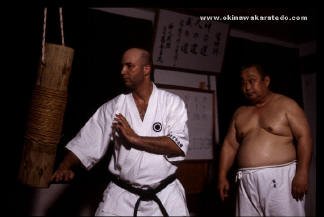
sage-makiwara
(hanging makiwara)
Daniel Kogan (Shinjibukan)
sensei Onaga Yoshimitsu
The practice of ‘fresh air’ punching only, never gives one the true feeling of actually striking or punching and opponent. This type of training also encourages bad striking and punching habits as there is no measure between your technique and end-result. Our heads are made up of bones and cartilage and is mostly hard and solid, similar to a standing makiwara (tachi makiwara) – see illustration. Therefore it is imperative that one’s hands are conditioned to resist the impact otherwise the first strike to your opponents’ head could damage the bones in your hands or wrist. The makiwara not only aids in strengthening the hands and arms, but it also helps strengthen one’s stance and coordinating one’s breathing. Punching ‘fresh air’ does not cover all these aspects.
The are two types of makiwara, the tachi-makiwara and the age-makiwara. The most common version of the makiwara is the standing makiwara (tachi makiwara). However, there are also two types of standing makiwara:
(a) a flat wooden post extending up from the ground with a pad (or straw wrap-around) on the top. This makiwara is struck from the front only.
(b) The other type of standing makiwara is constructed of a round pole which is set into the ground as well. Straw padding is wound around the pole, and it can be hit from all sides.
 Chishi – weighted lever
Chishi – weighted lever
Chi-shi training is also extremely vital to okinawan karate. It should be used side by side with the practice of Sanchin and Naifanchi kata. Correct use of the chi-shi will improve muscle tone, strength in the fingers, hands, arms and chest (amongst many other parts of the body), however these are only the external benefits. The ligaments and cartilage of the wrist, elbows and shoulder joints will also benefit from this form of training. Initially, I mentioned ‘correct use of the chi-shi’, as incorrect use will definitely cause great damage, which could become permanent. Jerky movements and using too heavy a chi-shi can contribute to this disaster. Good posture and correct techniques are important, and should never be sacrificed for an increased number of repetition. The shoulders should be kept on a horizontal plane despite the weight being asserted to one side. I often practice with the chi-shi using shiko-dachi. This helps me keep the hips low thereby aiding my balance. The movements should be performed in a deliberate and slowish way.What might not be apparent when watching a person using the chi-shi, is the strong grip required in the wrist and hands. Okinawan karate relies heavily on gripping, grabbing and tearing techniques, therefore the necessity for good strength in the arms, wrist, hands and fingers. At the completion of a movement the grip should be tightened, focused and sustained for a short while. This grip/release grip action will stimulate the muscles of the arms, wrist, hands and fingers. When moving the chi-shi to different angles, focus that grip at those angles as well as this will improve you grip even at unusual angles and directions.
 Sashi weights
Sashi weights
Sashi, hand held weights used during blocking and striking practice. Traditionally sashi is made of stone. A pair of 6-10 pound dumb-bells serve the same purpose. This exercise is very good for developing arm and shoulder strength.
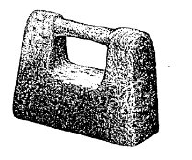
 Kami – gripping jar
Kami – gripping jar
As mentioned previously, okinawan karate relies heavily on gripping, grabbing and tearing techniques, and another device that is wonderful in these aspects in the kami, or gripping jar. Using this implement while stepping in Sanchin, Zenkutsu, Shiko or Neko Ashi Dachi also assists the lower body and posture. The lip of the jar is gripped with all the fingers and the thumb is actually positioned underneath the lip (tip of thumb pointing backwards in your direction).
A good exercise is to step in Sanchin dachi, root yourself then list the kami in front of you until it is horizontal to the ground, hold it out there then roll the wrist around turning the kami around, return the wrist to the original position then slowly bring it down to your side, then step forward and repeat with the other hand. As with the chi-shi all movements should be done with a deliberate movement (muchimi) and not with jerky movements. Jars are filled with sand or water.
 Tetsu geta – iron clogs
Tetsu geta – iron clogs
These are iron clogs, used to strengthen kicking techniques.
The Tetsu-geta or iron sandals, for leg strength and kicking. (Much better for foot strength than modern ankle weights. The foot actually must grip the sandal, and the weight is at the far extremity of the limb, adding to the difficulty of the device. Because of this, fast kicking, which would be dangerous to the joints if using ankle weights, is not possible, and therefore the use of the tetsu-geta is preferred to the modern devices.)
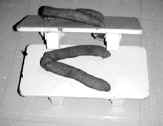
 Makiage kigu
Makiage kigu
wrist roller
This is a wrist roller, a wooden handle with a weight hung in the center on a rope. You twist the handle and wrap the rope onto it, raising and lowering the weight, and strengthening the wrists and grip.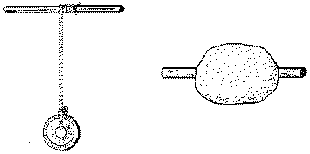
 Yari bako – gripping
Yari bako – gripping
This is just a box or bowl filled with sand, beans, gravel or similar material. Fingers are thrust into it to toughen the hands.
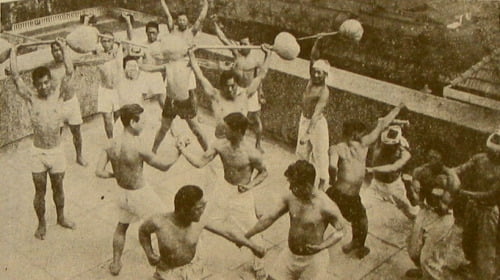
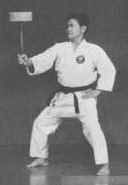 Chishi – weighted lever
Chishi – weighted lever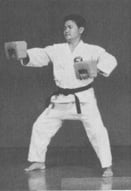 Sashi weights
Sashi weights Kami – gripping jar
Kami – gripping jar Tetsu geta – iron clogs
Tetsu geta – iron clogs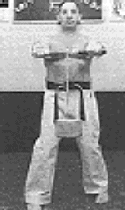 Makiage kigu
Makiage kigu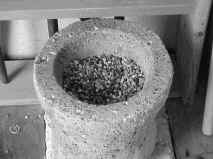 Yari bako – gripping
Yari bako – gripping